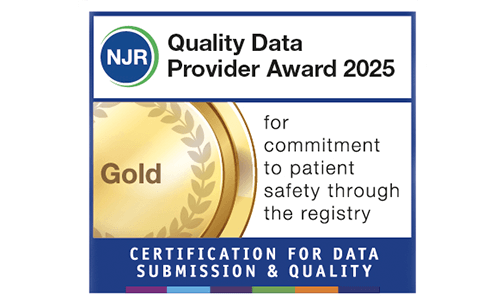What is a herniated disc?
A herniated disc, also called a bulging, prolapsed or slipped disc, happens when the soft centre of one of your spinal discs pushes out through a tear in its outer layer. This can press on nearby nerves, causing pain, numbness, or weakness, especially in your back, neck, or legs. Most cases improve with rest, gentle exercise, and pain relief, while surgery is only needed in persistent or severe cases.
Each disc in your spine has a soft centre (nucleus) surrounded by a tough outer ring (annulus). A herniated disc happens when the nucleus pushes through a tear in the annulus, often due to age-related wear and tear, injury, or repetitive strain.
This condition can affect any part of your spine, but is most common in the lower back. Depending on the location and severity, the main herniated disc symptoms are:
Some people have no symptoms at all, and discover the issue only through imaging tests. For those who do experience discomfort, symptoms often improve within four to six weeks with conservative care.
Herniated disc symptoms
A herniated disc can cause a range of symptoms depending on its location and severity. While some people experience no signs at all, others may notice pain, numbness, or weakness in specific areas of the body. Understanding these symptoms early on can help you seek the right treatment before they get worse.
Symptoms of a herniated disc in your lower back (lumbar spine)
This is the most common area for disc herniation. Symptoms often affect one side of your body and may include:
-
Lower back pain that may be sharp or burning
-
Sciatica – shooting pain down your buttock, leg, and sometimes into your foot
-
Numbness or tingling in your leg or foot
-
Muscle weakness – difficulty lifting your foot or leg, stumbling
-
Pain that worsens when sitting, bending, coughing, or sneezing
Symptoms of a herniated disc in your neck (cervical spine)
When a disc presses on nerves in your neck, symptoms may radiate into your upper body and include:
-
Neck pain, especially at the back or sides
-
Pain in your shoulder, arm, or hand may feel sharp, burning, or electric
-
Numbness or tingling in the arm, hand, or fingers
-
Muscle weakness such as trouble gripping or lifting objects
-
Pain that worsens with head movement or turning.
General signs to watch for
-
Difficulty bending or straightening your back
-
Pain that worsens with movement or certain positions
-
Radiating symptoms (pain, tingling, weakness) in your limbs.
However, some people experience no symptoms at all and their herniated disc is found incidentally on scans.
If you’re experiencing any of these herniated disc symptoms, especially if they’re persistent, worsening, or affecting your mobility, it’s important to book an appointment with your doctor. Early diagnosis can help prevent complications and guide effective treatment.
When to see a doctor about a slipped disc
While most slipped discs improve on their own, see your doctor if:
-
Your pain isn’t improving after a few weeks
-
Painkillers aren’t working
-
Your pain is worse at night or affects your sleep
-
You have fever, weight loss, or swelling in your back
-
You feel numbness, tingling, or weakness in your arms or legs
Seek urgent help if you suddenly lose bladder or bowel control, struggle to walk, or have pain after an injury. These could be signs of serious nerve pressure.
What causes herniated discs?
A herniated disc is often caused by a combination of age-related changes and physical strain, though in many cases, patients can’t identify a specific trigger.
Common causes of a herniated disc include:
-
Natural wear and tear - as you age, your spinal discs lose flexibility and hydration, making them more prone to cracking or tearing, a process is called disc degeneration.
-
Improper lifting - using your back instead of your legs to lift heavy objects, or twisting while lifting, can put excess pressure on your spine.
-
Repetitive movements - jobs or activities that involve frequent bending, twisting, or heavy lifting can gradually stress your discs.
-
Sudden injuries - falls, car accidents, or direct trauma to your spine can cause a disc to rupture.
-
Poor posture or prolonged sitting - sitting for long periods, especially with poor posture, increases pressure on your lower back.
-
Excess weight - carrying extra body weight adds strain to your spinal discs, especially in your lower back.
-
Smoking - reduces oxygen supply to your discs, speeding up degeneration.
-
Genetics - some people may inherit a predisposition to disc problems.
Often, it’s difficult to pinpoint exactly what caused a herniated disc. It may develop gradually or result from a minor movement that wouldn’t normally cause injury.
Herniated disc risk factors
Risk factors for a herniated disc include:
-
Age - most common between ages 30 and 50 due to natural disc degeneration
-
Sex - men are affected more often than women
-
Excess body weight - adds pressure to spinal discs, especially in your lower back
-
Physically demanding jobs - repetitive lifting, bending, twisting, or pulling increases strain
-
Improper lifting techniques - using your back instead of your legs can trigger disc injury
-
Sedentary lifestyle - lack of regular movement weakens your spinal support muscles
-
Frequent driving - long periods of sitting and vibration from vehicles can stress your spine
-
Smoking - reduces the oxygen supply to your discs, speeding up degeneration
-
Genetics - a family history may predispose you to disc problems
-
Connective tissue disorders - conditions like Ehlers-Danlos or Marfan syndrome may increase spinal instability
-
Diabetes - may affect your disc health through inflammation and metabolic changes
-
Height - taller individuals may have a slightly higher risk due to spinal mechanics.
Herniated disc diagnosis
Diagnosing disc herniation involves a combination of a physical examination, a neurological assessment, and imaging tests to confirm the location and severity of your disc problem.
Physical and neurological examination
Your doctor will begin with a thorough physical exam, which may include:
-
Checking for tenderness along your spine
-
Assessing your range of motion and pain during movement
-
Performing a straight leg raise test (for lower back issues). This involves lying flat while your leg is gently lifted and if you have pain radiating down your leg it may suggest nerve compression
-
Conducting a neurological exam to evaluate your:
These tests help identify which of your spinal nerves may be affected.
Imaging tests
If symptoms persist or diagnosis is unclear, your doctor may order one or more of the following:
-
MRI scan - the gold standard for detecting herniated discs. It shows soft tissues, disc position, and nerve involvement.
-
CT scan - produces cross-sectional images of your spine. It’s useful if MRI isn’t suitable.
-
X-ray - doesn’t show herniated discs directly but can rule out fractures, tumours, or spinal misalignment.
-
Myelogram - a dye is injected into your spinal fluid before a CT scan to highlight nerve compression.
Nerve function tests
Nerve function tests help assess how well your nerves and muscles are working:
Herniated disc treatment
Most herniated discs improve with time and conservative care, but when symptoms persist, a range of treatments can help relieve pain and restore mobility. Below is an overview of the main herniated disc treatments.
Medication and painkillers for a herniated disc
Medications can help with disc herniation management including reducing pain, inflammation, and nerve irritation. Types of medications and painkillers are:
-
Over-the-counter pain relief - includes acetaminophen (e.g. Tylenol), ibuprofen (e.g. Advil), or naproxen (e.g. Aleve)
-
Neuropathic pain medications - target nerve pain and include gabapentin, pregabalin, duloxetine, and venlafaxine
-
Muscle relaxant - prescribed for muscle spasms; common side effects include drowsiness and dizziness
-
Opioids - used cautiously for severe pain when other medications fail. Examples include codeine or oxycodone-acetaminophen (Percocet)
-
Corticosteroids - may be taken orally or injected to reduce inflammation around spinal nerves.
Injections
If oral medications don’t provide relief, spinal injections may be recommended. They include:
-
Epidural steroid injections - deliver anti-inflammatory medication directly into the epidural space around your spinal nerves
-
Nerve root blocks - target specific nerve roots to reduce pain and confirm diagnosis
-
Caudal injections - administered at the base of your spine, often guided by imaging for precision.
These injections can reduce swelling and nerve irritation, helping you to regain mobility and engage in physiotherapy.
Physiotherapy
Physiotherapy is a cornerstone in disc herniation management, helping improve strength, flexibility, and posture. It can include:
-
Targeted exercises – to strengthen your core muscles and relieve pressure on your spinal nerves
-
Stretching and aerobic activity – to improve circulation and reduce stiffness
-
Manual therapy - includes massage, joint mobilisation, and traction
-
Education and posture training - helps prevent recurrence and supports long-term recovery.
A physiotherapist will tailor a program of herniated disc exercises and therapies based on your symptoms and spinal location.
Surgery
Spinal surgery is considered when symptoms persist despite conservative treatment, or if there’s nerve damage or loss of bladder/bowel control. Herniated disc surgeries include:
-
Microdiscectomy - minimally invasive removal of the herniated portion of your disc
-
Discectomy - removal of your damaged disc to relieve nerve pressure
-
Laminotomy/Laminectomy - removal of part or all of your vertebral lamina to access and decompress nerves
-
Spinal fusion - joins vertebrae to stabilise your spine after disc removal
-
Artificial disc replacement - replaces your damaged disc with a synthetic one to preserve motion.
Herniated disc surgery is typically a last resort and may involve a recovery period of several weeks.
Ramsay Health Care UK offers a range of spinal surgeries, including lumbar discectomy and microdiscectomy, performed by expert spinal surgeons using advanced techniques.
How to prevent a herniated disc
To help reduce your risk of developing a herniated disc, small lifestyle changes can make a big difference. Here are practical steps you can take:
-
Stay active - regular exercise strengthens your core and back muscles, which support your spine
-
Use proper lifting techniques - bend at the knees, not the waist, and lift with your legs, not your back
-
Maintain good posture - sit and stand with your spine aligned; avoid slouching, especially during long periods of sitting
-
Keep a healthy weight - excess weight adds pressure to spinal discs, especially in your lower back
-
Stretch regularly - gentle stretches improve flexibility and reduce muscle tension around your spine
-
Wear supportive footwear - avoid high heels and choose shoes that help maintain spinal alignment
-
Take breaks from sitting - move around every 30 to 60 minutes to relieve pressure on your spine
-
Manage stress - tension can tighten muscles and increase spinal strain; relaxation techniques can help
-
Quit smoking - nicotine reduces blood flow to your spinal discs, speeding up degeneration.
These habits not only help prevent disc problems but also support your overall spinal health.
Herniated disc recovery time
Recovery from a herniated disc usually takes 2 to 6 weeks, but can vary depending on how severe the issue is and how well treatment is followed. Sometimes herniated disc treatment can take several months to be effective, especially if nerve pain or weakness is involved.
Factors that can affect your recovery time include:
-
Your age and general health
-
Where the disc is located
-
How active or sedentary you are
-
How well you stick to physiotherapy and posture advice
-
Smoking, stress, or underlying conditions like diabetes.
Signs a herniated disc is healing
As a herniated disc begins to heal, patients often notice gradual improvements in how they feel and move. While recovery varies from person to person, here are some common signs of herniated disc healing:
-
Reduced pain - sharp or radiating pain (like sciatica) may become duller, less frequent, or shift closer to your spine
-
Improved mobility - you may find it easier to bend, walk, or sit without discomfort
-
Less numbness or tingling - sensations in your arms or legs may fade as nerve pressure eases
-
Decreased muscle spasms - muscles around the affected area begin to relax
-
Better sleep - less pain at night can lead to more restful sleep
-
Lower reliance on medication - needing fewer painkillers may signal natural recovery
-
Return of strength - muscle weakness caused by nerve compression may gradually improve
-
Longer gaps between flare-ups - symptoms become less frequent and more manageable.
These changes often happen over several weeks, with most people seeing progress between 2 to 6 weeks. If your hernia symptoms continue to improve and daily activities become easier, it’s a good sign your disc is healing.


